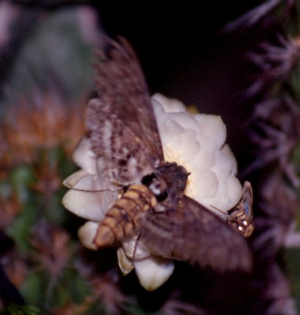Cocytius antaeus
| Cocytius antaeus | ||||||||||||
|---|---|---|---|---|---|---|---|---|---|---|---|---|

Cocytius antaeus |
||||||||||||
| Systematics | ||||||||||||
|
||||||||||||
| Scientific name of the genus | ||||||||||||
| Cocytius | ||||||||||||
| Huebner , 1819 | ||||||||||||
| Scientific name of the species | ||||||||||||
| Cocytius antaeus | ||||||||||||
| ( Drury , 1773) |
Cocytius Antaeus is a butterfly ( moth ) from the family of moth (Sphingidae). It is the only species in the genus Cocytius . In addition to the nominate subspecies, the subspecies Cocytius antaeus medor (Stoll, 1782) is known from the literature, but the division of the species into two subspecies is probably not justified.
features
The moths reach forewing lengths of 65 to 92 millimeters, making Cocytius antaeus the largest species of swarming found in North America and one of the largest swarmers in the Americas. The proboscis reaches a length of 160 millimeters. The moths have brownish-gray marbled forewings and are only slightly variable in color. The hind wings have conspicuously large, transparent areas in the middle and a strong yellow spot at the base. These features distinguish the species from the similar species Amphonyx duponchel and Neococytius cluentius, which occasionally occur in North America, in addition to their size . The former, smaller species has a dark blue-green tinge on the forewings. It also lacks the tooth-like scaling that extends between the wing veins into the transparent areas of the hind wings. The second, similar species is about the same size as Cocytius antaeus , but has less marbled fore wings and instead of the transparent area on the hind wings has an opaque, yellowish-white band.
The caterpillars are up to 160 millimeters long. Their coloring is not variable. After hatching, they have a relatively large, pointed head and a very granular body surface. When fully grown, their bodies are covered with fine reddish hair, which is unusual for the otherwise naked hawk caterpillars. They have a purple longitudinal line along the back. These features clearly identify the species. Otherwise, their body color is solid green. Noticeable is a whitish oblique line on the sides that leads to the base of the anal horn . At the same time, there are other oblique, dark green lines along the sides of the body.
The shimmering mahogany brown doll has a very compact, exposed, curved trunk sheath. This is provided with strong sloping grooves. On each individual segment there is hair that clearly protrudes from the body. The Kremaster is very strong and pointed.
distribution and habitat
The species occurs from Florida over tropical America to the south of Brazil. She also flies in the tropical and subtropical plains of Jamaica. It is also rarely found in the south of Texas, although it can be detected as a random visitor north as far as Chicago. There is also evidence of the species from the Galapagos Islands .
The species inhabits deciduous forests in Florida, close to the water and in elevated areas in the Everglades , where the caterpillar forage plant Annona glabra grows. The habitats are very humid and difficult to access, so that it is not always easy to identify the species.
Way of life
Because of its long proboscis, the species is probably the only one that can pollinate deep calyx orchids such as Polyrrhiza lindenii in Florida .
Flight and caterpillar times
In North America, the species can fly year round, but is most common from June to November. It is unclear whether more than one generation is trained each year.
Food of the caterpillars
The caterpillars feed on Annona glabra , Annona reticulata , Annona purpurea , Annona holosericea and Rollinia membranacea , from the Annonaceae family.
development
The females lay their eggs individually on the underside of the leaves of the host plants. From the beginning, the caterpillars can also tolerate old, tough leaves. In the first three caterpillar stages, characteristic tracks are eaten from the outer edge of the leaf to the midrib, on which the caterpillars always sit on the underside of the leaf. Older caterpillars first eat the leaves at the end of a branch and then eat their way down to the base of the branch. They stay on the underside of the branches. In the last stage of the caterpillar, the manure no longer consists of larger balls, but of small pieces. When disturbed, the caterpillars behave violently.
Pupation takes place on slightly elevated beach banks in a shallow pit, which is reinforced by plant material spun with silk.
supporting documents
Individual evidence
- ↑ Cocytius Hübner, 1819. Sphingidae Taxonomic Inventory, accessed July 1, 2015 .
- ↑ a b c d e f g h i James P. Tuttle: The Hawkmoths of North America, A Natural History Study of the Sphingidae of the United States and Canada. The Wedge Entomological Research Foundation, Washington, DC 2007, ISBN 978-0-9796633-0-7 .
- ↑ a b c Sphingidae of the Americas. Bill Oehlke, accessed December 16, 2011 .
literature
- James P. Tuttle: The Hawkmoths of North America, A Natural History Study of the Sphingidae of the United States and Canada. The Wedge Entomological Research Foundation, Washington, DC 2007, ISBN 978-0-9796633-0-7 .



